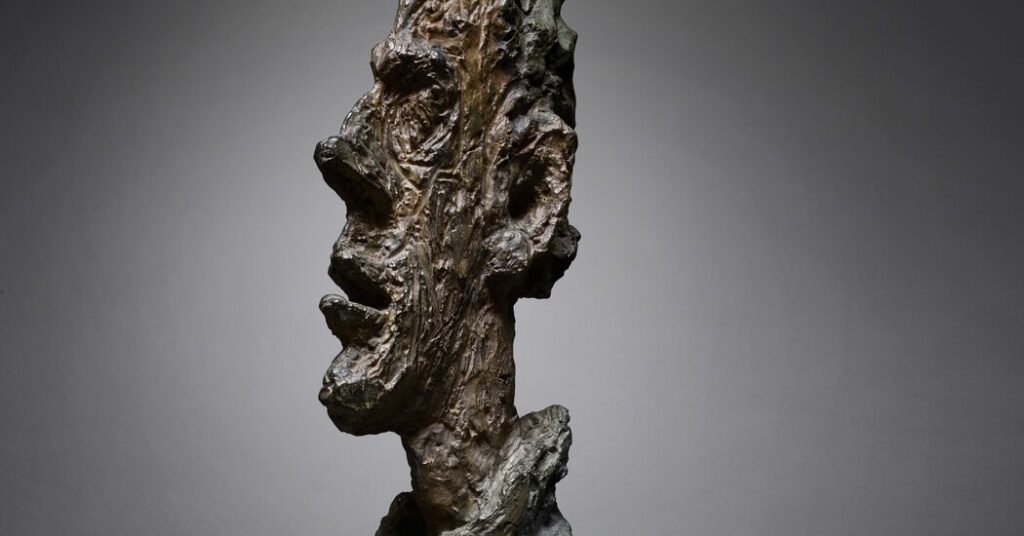There were gasps, and a pall came over the entire salesroom.
What was meant to be the most expensive lot of New York’s bellwether spring auctions suddenly looked like a costly mistake.
Alberto Giacometti’s 1955 bust, “Grand tête mince (Grand tête de Diego),” carried a pre-sale estimate of over $70 million into Sotheby’s Modern evening auction on Tuesday. The artwork was being offered by the Soloviev Foundation, a nonprofit established by the real estate magnate Sheldon H. Solow, who died in 2020.
Despite an unsettled economy, the artwork came to the market without a minimum price guarantee from the auction house, which would have ensured the seller received a predetermined price, regardless of the outcome. Solow, auction experts said, had a history of not seeking guarantees, choosing to negotiate for a portion of the buyer’s fees instead. Last night that strategy proved fateful.
Oliver Barker, the evening’s auctioneer, began the bidding for the bust at $59 million. But his bids stalled at $64.25 million. Three minutes passed as he hunched low over the rostrum, hunting for bidders, Nosferatu-like, until announcing that the lot was a pass.
Several experts agreed that the artwork’s aggressive estimate was the original sin.
The artwork’s failure to sell was a body blow to Sotheby’s Modern sale. The textured Giacometti made up almost 30 percent of the auction’s presale low estimate of $240.3 million. The sale as a whole generated only $152 million after fees were stripped out.
Giacometti made six casts of “Grand tête mince” (“Big Thin Head”), modeled after his brother Diego, during his lifetime. Two of those casts were auctioned in the early 2010s, with the most recent selling at Sotheby’s in 2013 for just over $50 million, with fees. The seller was looking to achieve $70 million or more for its cast, which is the only painted version.
“No one who is an informed buyer who is serious in this market — billionaire or not — is going to pay what essentially amounts to a 50 percent premium on something that sold in recent memory,” said Todd Levin, an adviser in New York.
Between consigning an artwork and auctioning it, auction house specialists rigorously gauge the market to determine whether the estimate still aligns with market demand. If not, the estimate or the reserve price can be lowered to increase the likelihood of a sale. The lot could also be withdrawn to prevent a public failure.
Yet lowering the reserve and withdrawing a lot both typically require the consignor’s approval. If he or she stands firm, the sale will go ahead.
Second-guessing also surrounds the seller’s unwillingness to accept a guarantee from Sotheby’s. Sources close to the auction say that Solow’s family had preferred to offer the work unprotected by a guarantee, to maximize the foundation’s profit. Sotheby’s supported the request for a traditional auction.
“There is an argument to be made that while guarantees typically undermine competitive bidding on a lot, in the case of the Giacometti one might have provided collectors with assurance and permission to pursue the sculpture,” said Alex Glauber, the president of the Association of Professional Art Advisors.
The fear within the auction world is that the bust’s flop could now taint casual perceptions of the overall health of the art market, when it was Sotheby’s, and the seller, who agreed to expose an object of economic importance to the risks of an unpredictable market.
“A piece like this, at this level, really is a singular entity,” Levin said. “Trying to pull any opinion about the broad art market from this specificity would be an error.”
The Giacometti was the second high-profile lot to disappoint in two days. Andy Warhol’s “Big Electric Chair” (1967-68) was withdrawn from Christie’s 20th century evening auction on Monday. The work had been estimated to sell for about $30 million.
“Between Christie’s pulling the Warhol ‘Electric Chair’ and the Giacometti failing to sell at Sotheby’s, it’s clear that the air is incredibly thin at the upper pricing band of the market, even for masterworks by tried and true names,” Glauber added.
Julian Dawes, vice chairman of Sotheby’s and head of Impressionist and Modern art, explained the decision to go forward without withdrawing the work: “We had serious interest from major collectors.” He added, “We had people poised to bid on this work, and that is why we felt a responsibility to ourselves and to the seller to keep it in the auction and to give it that chance.”
An item that fails to sell at an auction is said to have been “burned” and may have difficulty finding a buyer anytime soon at a similar price.


